IPF Webinar on "The Truth about Moplah Riots 1921: Agrarian Uprising or Forest Banditry?"
Total Views |
IPF Webinar on
"The Truth about Moplah Riots 1921: Agrarian Uprising or Forest Banditry?"
September 11, 2021
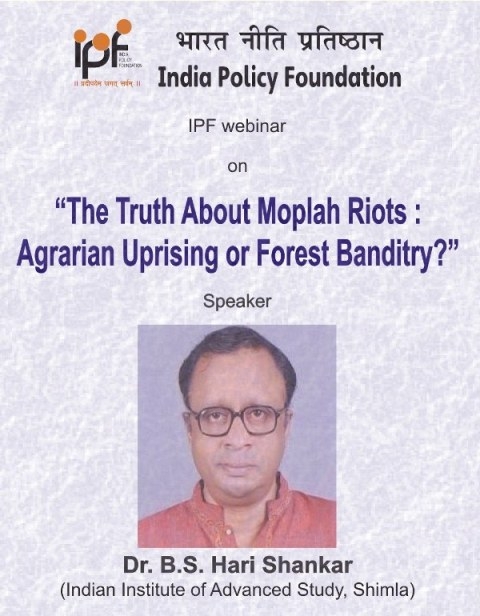
Speaker:
Dr. B.S. Hari Shankar, Indian Institute of Advanced Study, Shimla
Moderator:
Dr Kuldeep Ratnoo, Director, India Policy Foundation
Dr Kuldeep Ratnoo:
Good evening! Today, we are here to discuss the Moplah rebellion of 1921 that happened in Malabar, Kerala. This incident has often been presented by Left historians as an agrarian uprising. But 100 years since the event, it is clear that the violence was purely communal in nature and was not related to any agrarian grievance or peasant unrest. There have been actual records and there have been reports, British accounts, Indian political leaders’ accounts and various other documentary proofs which prove that it was a well-planned genocide of Hindus. The attackers were not poor landless labourers, peasants or tenants, there was much more to it.
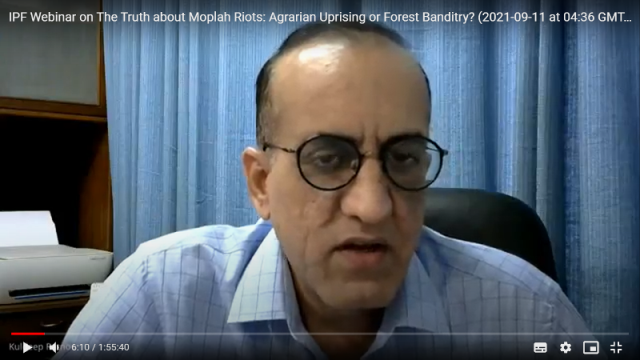
We are very happy to have Dr B.S. Harishankar with us today. He has recently written a book, “Beyond Rampage.” The book covers a different angle which was hitherto unknown to us. This book was released in July in Thiruvananthapuram and in August in Delhi. We requested Dr Harishankar to come and address us and to provide us insights about what happened during Moplah riots.
Moplah riot unfortunately is a part of Indian history and is a part of Khilafat movement. We all know what Khilafat movementwas. After the First World War, there was an agitation among Muslims. They wanted reimposition of Ottoman Caliphate and Indian Muslims got agitated and they also joined hands. The Ali brothers and Maulana Azad led the movement and they appealed to all Muslims to agitate and demand that the Caliphate should be reinstated. This movement was termed as Khilafat movement.
Gandhiji had returned from South Africa and he had some very terrible experiences of dealing with Muslims over there and he felt that in India to launch a wider freedom struggle or agitation against British, he needed the support of Muslims. While observing the Khilafat movement and seeing the anger among Indian Muslims, Gandhiji felt that if he supported it, Indian Muslims will also join his call for freedom from British colonialism. And out of this, I would say, desperation to get the support of Muslims, Gandhiji fully supported Khilafat movement. Not only did he support, he put the entire Congress machinery including Congress resources, funds and workers behind Khilafat movement. That much has been known and that much has been taught to us in history books.
Unfortunately, the Khilafat movement remained a pan Islamist movement. There was a very clear-cut agenda behind it and lot of rumours and lot of misinformation were spread during that period. And one particular rumour was about attack by the ruler of Afghanistan and capturing Delhi and establishing an Islamic rule over India. And the Muslims in Malabar region who were termed as Moplahs, some writers in Malabar region write is as ‘Mappilas’, they were appealed. A series of incidents had been going on. There were some preachers from Arabia who were instigating the Muslims to revolt and convert this nation into an Islamic nation. So, inspired by the rumours of Afghans capturing Delhi, the Moplahs got agitated and they started attacking the Hindus in the Malabar region. The history which we have been taught is that it was a freedom struggle and the struggle was against the British and in the process, some Hindu landlords who were hand in glove with the British were also attacked. Ultimately, it was a “minor incident” but the larger objective of the riot was the revolt against the British. But now we have realised, read the facts and come to the conclusion that it wasn’t so. It was genocide and a communal riot with intention to establish an Islamic rule in the Malabar region. The Left historians and the Communist government were hand in glove with the Congress government in the Centre. They somehow brushed aside all these unpleasant facts about the riots which included Hindu genocide, butchery, rape and torture of women and children. Hundred years later, we are again getting reminded of the Taliban in Afghanistan. But if we read about the history of what actually happened in the Moplah riots of 1921, everything else pales in comparison to its brutality and inhumanness.
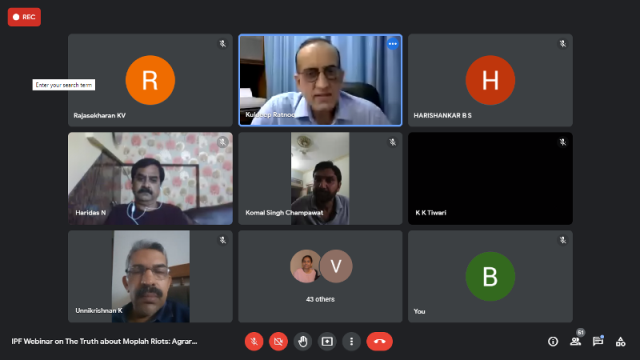
We are very lucky to have Dr Harishankarji with us to talk about this. Dr B.S. Harishankar did his Ph.D. from Pune University in 1999. Thereafter, he did two post-doctoral studies. The first was awarded by the Indian Council of Historical Research (ICHR) in 2002 and completed at University of Kerala. In 2015, he was awarded Kali Charan Puri fellowship by India Policy Foundation for his work in archaeology. He completed that in 2018. He has worked in various organisations and has handled different roles. He has written several books. He has eight works in archaeology and history to his credit, including one in Malayalam. He has also been an Assistant Editor of Puratattva, a journal on Indian archaeology. That was in the early 90s. He has also published research articles in various journals including the British Archaeological Reports at Oxford. He has presented numerous papers in various national and international conferences, seminars, workshops on history and archaeology. He has also chaired thematic sessions in various national conferences. He writes regularly on history, archaeology, culture and related issues. Currently Dr Harishankar is Member, Academic Committee, Indian Institute of Advanced Studies(IIAS) at Shimla. And he is also Member of Fellowships Grants Committee – Indian and foreign scholars at IIAS. He has undertaken study of archaeology of Northeast India for Vivekananda Kendra. He published the work under the title ‘Imprints of the Past.’ He has also exposed the Pattanam and Keezhadi archaeological sites in Kerala and Tamil Nadu which were sponsored by foreign universities and the Dravidian hardliners along with Leftist historians. His latest book, ‘Beyond Rampage: West Asian Contacts of Malabar and Khilafat’ was released very recently as I had earlier mentioned. I request Dr Harishankar to provide us more insights into Moplah riots and some hidden facts which were not known to us. And how these riotsweren’t about peasantry or the farmers and in fact, were against Hindus.
Dr. B.S. Hari Shankar
I thank Dr Kuldeep Ratnoo, Director, India Policy Foundation for giving me an opportunity to talk on the agrarian uprising questioning the credentials of the Moplah rebellion. It was due to the support I got from Shri Nandakumarji of Prajna Pravah that I was able to take this subject further ahead. Then I thank Shri Sanjayanji, Director, Bharatheeya Vichara Kendram who gave complete support for undertaking this project on Malabar rebellion although I was not much familiar with this topic on modern history. Basically, I am more inclined towards ancient Indian history. But because of the sensitivity of the subject and its relevance in current context, I was persuaded to take up this subject. Then I thank the distinguished audience who have patiently arrived and are listening to my talk here and giving an introduction to the book which was recently published.
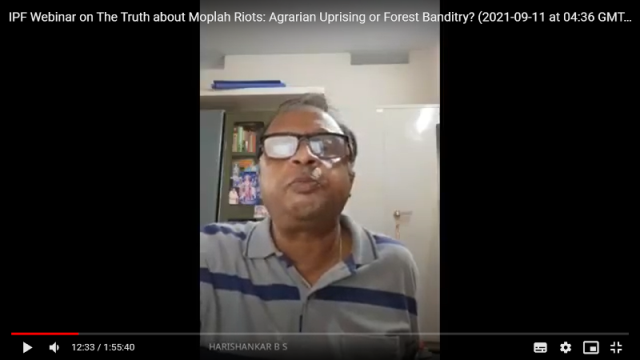
One year back, Mohammed Ayub, Professor Emeritus of Michigan University who has specialised in international relations wrote an article in The Hindu newspaper. It was titled, ‘Mappila Uprising.’ Prof Ayub emphasised that the anti-British sentiment among the Mappilas in Malabar was fuelled by the economic misery due to newly introduced tenancy laws that tremendously favoured the Hindu landlords and made the Moplahs landless. The landlords were upper caste Hindus and the entire tenants were Moplah Muslims. In fact, Prof Ayub was just echoing the left theories by Prof K.N. Panicker, Prof Bipin Chandra, Prof D N Dhanagare, Prof Ravindran Gopinath and others who narrated the ghastly Hindu carnage in Malabar as merely a peasant uprising against Hindu feudalism and British colonialism. Left historians constantly argue that the 1921 Moplah carnage or rampage was a peasant rebellion having both anti-feudal and anti-imperialistic content. The Left equations in Malabar present only Hindu landlords who supported the colonial state and the anti-feudal Moplah peasants who were ruthlessly exploited. They hide the facts on Moplah landlords and the Hindu peasants. It was a Left equation that was very shrewdly crafted to fit into a new theory and carve out new political and economic permutations and combinations.
I should emphasise here that Prof Conrad Woods, who himself is a distinguished Marxist scholar raised a serious question in his work.If Hindu tenants and labourers admittedly suffered quite as much if not more from the socio-economic system in Malabar, why were outbreaks confined exclusively to the Muslim community? Wood’s observation prompted another important question to be raised – why did there not occur a single uprising or even a slight protest by poor and exploited Moplahs against wealthy and affluent Moplah landlords in Malabar? We have a plethora of Moplah landlords such as Porrankanathu Unniyan, Vadakatte Mugari, Attenmoiyen Kurukal, Vallanpilakathu Hassan Kutty, Kunjali and Mohammed Kutty. These are only few among them. The Left historians have convenientlysuppressed the fact. Even the peasants were such a wealthy Moplah class in Malabar. But since the early 1970s, the picture that was given to us not only in textbooks but in hundreds of books and papers, was written and presented by the Left scholars. They claimed that the Moplah rebellion or the bloody Moplah uprising was against the Hindu landlords and the colonial state.
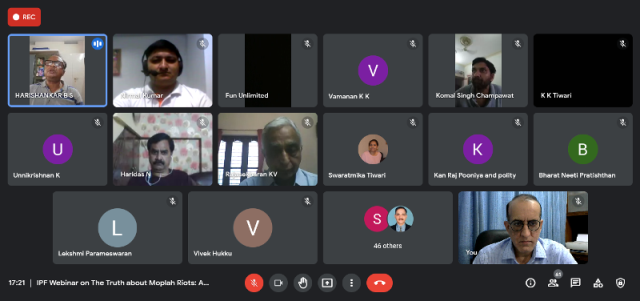
In this context, where the Moplahs of Malabar are presented as poor cousins or deprived tenants, we have to look into the past, covering an area of nearly 15009 sqkm – the former Malabar district which was part of the former exclusive British Madras presidency. On the eastern side of Malabar, we can find the Western Ghats with a strictly forested area and Arabian Sea on the west. This remained a premier zone for spice trade with West Asia for more than six centuries. Studies on maritime trade and inland trade of extremely rich Moplah merchants who were also wealthy land owners in Malabar change our hitherto views on the impoverished and exploited Moplah community of Malabar propagated by Left historians who totally set aside the geographical setting of Malabar in historical context. There were two factors which helped the maritime trade of Malabar. The first one was the climate. The south-west monsoons in Malabar helped the incoming vessels on the Malabar coast, from West Asia and other parts of the globe. The vessels here remained for nearly three to four months. By November-December, the south-east monsoons helped these vessels to go back to their respective homelands. And then, there were numerous rivers, inland river systems or waterways which were finely connected with the coastal areas. So, it was very easy to collect spices from the inland areas and bring them to the coastal zones and handover them to the traders. It was this environmental setting that greatly helped the trade of Malabar. Thus, this trade network for nearly six to seven centuries helped the emergence of an ICD, that is the Islamic Commercial Diaspora in Malabar. The close cultural interactions of Arab merchants, their Muslim trading partners and Islamic clergy with a mission for propagating Islam – these all factors, gave it a vast framework. The significance of Malabar’s pepper trade in the Arabian Sea, the crucial space being carved out occupied the global trade and the pivotal role that Malabari Muslim merchants played are all crucial in understanding the socio-economic history of Malabar in the present context.
From the 14th century, we can find how Malabar developed links with West Asia especially with the port of Jeddah. Jeddah is situated at the gateway to Mecca on the eastern shore of Red Sea. It was connected with Malabar in the context of spice trade. So, they developed a spice route in the history of ancient trade. In fact, when we look into the economy of the Arabian region, we can find that after oil, the first factor was pilgrimage that sustained Saudi Arabia’s economy from the first millennium A.D. It was two factors – oil and pilgrimage – that sustained Saudi Arabia for more than a thousand years. When we look at Malabar, we can find that there were 40 Muslim mercantile houses and landlords between 1600-1900 A.D. Unscrupulously, the Left historians are totally silent on the association of Jeddah and Ottoman Empire with Malabar and the strong bondage of Mamburam Thangals, the Sunni clergy with Istanbul and West Asia through the Hadhrami tradition which began nearly two centuries before the Khilafat movement started in Malabar. So, with the strong bondage, mercantile links and trade routes that developed between Malabar and West Asia, we can find that the region called Ponnani in South Malabar developed strong bonds with West Asia and became the spiritual locus of Malabar Ulema and orthodox Sunni tradition. They issued various fatwas. The beginning of fatwas in Malabar begins from Ponnani. They issued fatwas against the Portuguese, even asked support from the Ottoman clergy to fight against Christianity and uproot Christianity from the Malabar region. These fatwas which were first issued during the Portugal period were later reused against the Hindu society from the 1860s. It culminated in the 1921 Malabar carnage.
I told you earlier that there were 40 Moplah business houses in Malabar. The Ali Rajas of Arakkal in North Malabar were both Islamic rulers and prominent maritime traders. The Arakkal house encouraged the spread of Islam in Malabar. Khan Bahadur Sultan Abdul Rahman Ali Raja was elected member from Chirakkaltalukin Madras legislative assembly in 1940. This gentleman, Khan Bahadur Sultan Abdul Rahman Ali Raja became the vice president of the Madras State Muslim League. Then we can find a major Moplah mercantile group at Koyilandy, Kozhikode who owned ships and traded with Red Sea. Then there were the Kays and the Koyas, two dominant mercantile houses in coastal towns particularly in Thalaserry and Kozhikode. The Baramis and Thimings were the Hardhami group who were migrants from Hadhramaut to Malabar. They were concentrated in Kozhikode or Calicut. The Kay Mappila Muslims who were tycoons also owned properties in Mumbai, Kozhikode, Trivandrum and Mangalore. Other wealthy Moplah lineage in Malabar are the Kondotty Thangals. The propounder of Kondotty Thangals or the Shah Thangals belong to the Shia tradition. They were disliked and hated by the orthodox Sunni Moplahs in Malabar. Similarly, the Bafakis became Hadhrami Sayyids who migrated to Malabar from Yemen. And among them, Abdurrahiman Bafaki Tangal in Kozhikode was a towering personality in commerce and politics of Moplahs in Kerala. The Nahas are the oldest Moplah family in Malabar and are traditionally big landowners. The Kallady family in Mannarkkad in Valluvanadtaluk were traditionally large timber merchants. Most of these families were also big timber merchants in Malabar. And timber played a pivotal role in the economy of Malabar. Especially, timber from the Nilambur area was much sought after in West Asia and Europe. It was internationally renowned timber.
Now we have an idea of the Moplah businesshouses and land owners in Malabar. And how these facts have been hidden and supressed by so-called Left historians. And how the Moplahs were presented before us as deprived, supressed, poor and ruthlessly exploited tenants in Malabarfor at least a thousand years. Now we are going to the second stage, the Moplah peasant and the Hindu landlord. This has been the picture that has been given to us by the Left historians. In fact Marxist historians from JNU like Prof K.N. Panikkarhave presented these 40 big business houses who had maritime trade with West Asia and Europe as “petty traders.” I shall give the full sentence which K.N. Panikkarhad used in his work, ‘Against the Lord and the State’ which was published with ICHR funding. He wrote, “The overwhelming majority of Moplahs were cultivating tenants, landless, labourers, petty traders and fishermen.” This is how they have presented the Moplahs in Malabar.
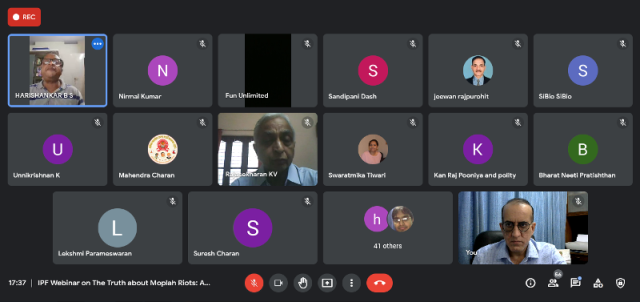
In fact, Malabar was never a land with extensive paddy cultivation. Large quantities of grains especially pulses and paddy were imported into Malabar from Kochi, Kanara, Konkan coast, the early Madras presidency and Bengal. What was cultivated in Malabar? That we should know. In South Malabar, we get a topography that is different. South Malabar is hills and hillocks and dense forest. So, what was constantly cultivated in South Malabar was ginger. Exclusively ginger and some paddy cultivations here and there.One area was the exception and that is the Palakkad region. The Palakkad region was the only area where paddy was extensively cultivated and this Palakkad region was free from any riots. Malabar also underwent severe famines in 1865, 1866, 1876, 1877, 1878 and 1890 which severely ruined its cultivation,a major factor which has been kept aside or rather cornered by the historians. In fact, the socio-economic equilibrium of Malabar began to change after the invasion by Hyder Ali and Tipu Sultan from Mysore. After the Mysorian interludes which resulted in massacres, large scale destruction of temples and conversions, socio-economic equilibrium of Malabar got tilted. Before the invasion of the Mysorian sultans, Malabar had a harmonious social system where the Moplahs were in harmony with the Hindu society. It was after the interlude of the Mysorian sultans that things began to change. There were large scale destruction of temples, conversions and massacres. And we can see large scale migration of Hindus from Malabar region to Cochin and Travancore. These settlements which witnessed large scale migrations of Hindus from Malabar are Kozhikode, Wayanad, Kannur – exclusively North Malabar and Malappuram, Palakkad and Thrissur which were confined to South Malabar. We have taken these data from the Census reports of the Government of India. Once the Hindus migrated, the Moplah kanamdarstook possession of the lands owned by the Hindus. After the migration, Tipu Sultan’s army settled land revenue with the Moplah kanamdars. Kanam means giving the land in lease and these were the managers. They took possession of the land in Malabar that belonged to Hindus. The Moplah kanamdars appropriated land and revenue when Malabar was under Tipu.
Let me quote Prof Conrad Woods, the distinguished Marxist scholar again. According to him, in a very well documented case, the interest of the Muslim kanamdar was linked with the fortunes of Tipu Sultan. It was not linked with the Moplah tenants but it was linked with the fortunes of Tipu. So, once the British entered into an encounter with Tipu Sultan which led to the downfall of Tipu which resulted in the Treaty of Seringapatam, Malabar came under the rule of the East India Company. And once Tipu’s downfall happened and Malabar was annexed by the British, the migrant Hindus returned and reclaimed their land which was illegally possessed by Moplah kanamdars. Let me quote the distinguished, scholar Michelman. He argued that the gap between peasants and landowners was filled by a calculable number of Moplahs who not only became land owners and improved their economic situation and social status but later had fierce conflicts with Hindus after their return to Malabar. And once the British took charge of Malabar, they perceived one thing that they cannot go for an encounter with the Moplahs immediately after taking control of Malabar. So, in order to appease the Moplahs, the British appointed Moplahs in influential posts. Chemban Poker assumed the power of Revenue Officer in the Cheranad area. Subsequently, he became much more powerful than in the Tipu’s era. And utilising his official position, he acquired a good deal of land. Hindus of the Cheranad region complained of Poker’s oppressive behaviour like plundering and looting of their property. This has not been referred anywhere in the Left studies and narratives on the Moplah rebellion.
On 12 October 1849, Henry Valentine Conolly who was the Malabar Magistrate at that time and later became the collector of that district, observed that there were large number of Hindu tenants in Eranad-Valluvanad region of South Malabar and remarked that the Moplah tenants were in amity with their Moplah landlords and that they would have resorted to protest if they had any grievance. The Moplah tenants were not having any grievance against the Moplah landlords. But the violence was by Moplah tenants against the Hindu landlords. Let me say frankly, the zamindari system and landlordism have no religion. Exploitation is exploitation. There were no protests by Hindu tenants against Hindu landlords. This was the situation in 1850s as observed by Conolly.
In fact, the British manipulated the pre-colonial structures in India by infusing new blood for old in the proprietary body of permanent settlement in the east and the ryotwari settlement in the south and other permutations in different parts of the country. They completely ruined the system after taking charge of India, especially in Malabar. In fact, the colonial rule helped in recognising a powerful class who not only owned the land but had absolute control over the land to act as their agents. Prof Dharma Kumar has observed that by recognising the potential of landowners, British put the law behind private ownership for the first time in the history of India. Before, British rule, there was nothing like private property. It was the British who spoiled it. But here also, a serious question has to be raised. The new jenmi system which the British introduced in India was not confined to the Malabar region, it was also present in the Kanara and Tamil areas of South India and in other parts of India such as Bengal. But the riots took place only in Malabar. Why was it so?
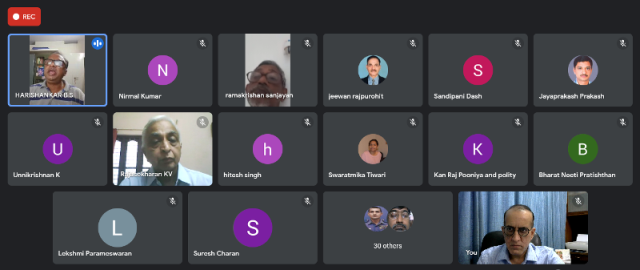
Let me put before you an example of Malabar in 1884 which was observed. Ossankutty Mammu, a Moplah tenant was threatened with eviction in March 1884 by both his Hindu and Moplah landlords. But he planed an outrage only against his Hindu landlord and his Moplah landlord was simply left untouched. How did this happen? I have an exclusively quoted Conard Wood’s observation. He said, “The indications at the beginning of the 19th century show that the economic position of the landlords in Malabar was risky and hazardous.” Stephen Dale in his work, ‘The Islamic Society on the South Asian Frontier’ accepts that the decisive factor in Moplah rebellion was religious and was not economic grievance. Let me quote the distinguished historian Thomas Madden. He has discussed how Marxists have interpreted the medieval European crusades in a particular way. They have narrated the crusades as an outcome of idealism. It has nothing to do with religion. Madden says that crusades took place in Europe because of population growth, scarcity in resources and surplus labour seeking new territories abroad. In other words, crusades were interpreted by Marxists as a search for job by unemployed youth from feudal Europe. This was the portrait given by Marxist scholars on crusades in Europe.
We have to look into another factor, a third stage in the development of the Malabar rebellion. It was the many causes for the pre-1921 riots. The Moplah uprising was not only the 1921 riots. In fact, before 1921, 50 riots took place in Malabar against the Hindu population in which Hindus lost both life and property. From late 1850s till 1920s, 50 riots took place in Malabar. It was not agrarian grievances but denial of land for construction of mosques adjacent to the temples that led to these attacks. When we verify the records, in all these cases, we can see that it was denial of land for construction of mosques that led to attacks. The ghastly murders like that of Kulathoor Warrier at Eranadin 1851, slaughter of 18 members of the Kallathil family at Mattannur, the attack on Karambara Nair in 1873 at Valluvanadtaluk and in 1852, the attack on Kulliyarathu Ananadanare all instances where the one and only cause for attacks was the denial of land for construction of mosques. We can’t find agrarian grievances here.
I shall quote one instance where how the question of construction of mosques near Hindu temples came up as a serious issue. In Thrikkariyoor which was the centre of the largest Moplah outbreak in 1884, a mosque was constructed near the largest Siva temple and this led to the grand outbreaks. In 1901, when the governor of the Madras presidency toured Malabar, he was presented with a petition by the Hidayatul Muslimin Sabhain which the main issues faced by the Moplahs in Malabar was underlined and given to the Governor. It was to persuade the landlords to allow construction of mosques. This was pointed out as the primary grievance of Moplahs in Malabar. The same year, the Moplahs of Kalpakanchery brought to the notice of the Collector of Malabar that a similar issue of denial of land for construction of mosques was there in the Islam Sabhaat Ponnani in South Malabar. On 12 August 1851, a memorandum signed by 12 prominent Hindus titled, ‘The petition of the undersigned Hindu inhabitants of Eranad, Sheranad and Valluvanadtaluks was submitted to the Malabar magistrate H.V. Conolly. This memorandum requested for granting the fundamental rights of Hindus to live in these taluks peacefully, to cultivate their lands and to maintain and sustain their families. The memorandum accused the affluent and wealthy Moplahs and the clergy for inciting frequent outrages against the Hindus in Malabar. This is a very clear and precise case in which the Hindus submitted a document. There were no outrages by the Hindus against the Moplahs.
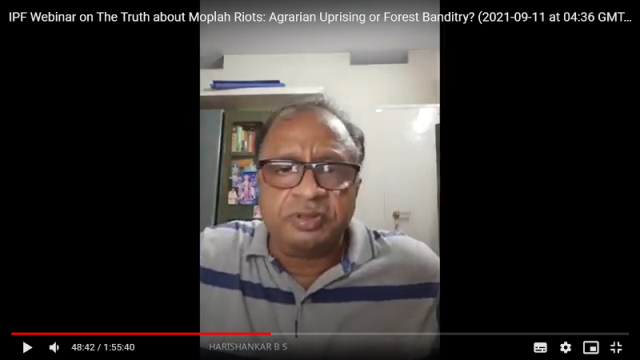
In fact, H.M. Winterbothamwho was a member of the Madras Board of Revenue astonishingly observed in 1896, “I am surprised that for the last 25 years outbreaks in Malabar occur within 15 miles of the Pandalur hills and I cannot profess to solve it.” The outbreaks never occur in paddy fields or in areas of cultivation. It is recorded in Madras judicial proceeding No:1567/Sep 30, 1986. Pandalur hill was one of the most densely forested areas in Eranadtaluk. Here, we see the influence of the powerful Moplah timber lobby and their presence in Malabar. In fact, the control of Malabar came under the British in 1792 in accordance with the Treaty of Seringapatam. The colonial authorities noticed the valuable timber wealth of Malabar forest and identified the Nilambur teak as the best substitute for oak to build ships for the British Navy. In South India, the finest quality teak came from Malabar and it was sent to Mumbai dockyard for ship building from the last decades of the second half of the 18th century. Teakwood from Nilmabur forest was used in the construction of Buckingham Palace, Kabba of Mecca, interior of Rolls-Royce car and the Titanic ship. This was the utility of timber from Malabar. In fact, William Logan and Malabar deputy collector C. Gopalan Nair have all referred and quoted extensively in their works, the prime importance of timber in Malabar not only in internal commerce but in international trade with global markets in West Asia and Europe. And the major role played by the Moplah timber houses in such transactions.
The Moplah riots before and during 1921 were concentrated in South Malabar. The Nilambur teak was located in this region of South Malabar. The forest of South Malabar can be divided into two ranges – the Nilambur and the Palakkad Forest ranges. The Nilambur division comprised the Nilmabur and Amarambalam ranges covering an area of 81,000 acres. The Palakad division has two ranges, Palakkad and Manarcaud covering an area of 1, 12,040 acres. This was the vast area covered by the teak plantation. Beypore in Malabar was the most famous harbour due to the superior quality timber from the hinterlands which was flowed to the Beypore area through the rivers. Rivers were used for cutting the trees and flowing them to the coastal region. There were very powerful Moplah merchants at various timber zones at Kallai, Beypore, Challiyum, Kadalundi, Mambattu, Nilambur, Ekkakara, Edavanna and Alamcode, all in Malabar which were one of the major timber outlets in peninsular India. In Malabar, the Kallai timber belt spreads over an area of around 35 km on both sides of the Kallairiver and it was known as the hub of timber market in South Asia and it occupied the second position in global timber trade and it controlled and regulated timber prices for several decades. This was the position enjoyed by teak in Malabar and how it controlled and regulated timber prices in the global market.
By the early 18th century, the Attappadi forest region in Malabar became the property of the Zamorins of Kozhikode. The Zamorins entrusted the administration of this area to three chieftains – Mannarkkad Moopil Nair, Palat Krishna Menon and Eralpad Raja. The forest areas of Malabar were the property of the deities of templesof Malabar and these chieftains were only managers. When the East India Company annexed Malabar, they set up a committee in 1805for a detailedsurvey of the timber resources. Joseph Watson who was appointed as conservator of forests unified the process of Malabar and Kanara to facilitate the timber trade. And timber trade virtually came into the hands of the British East India Company. And when timber trade was monopolised by the British, it was the Moplahs who lost their hegemony in timber trade which they had for centuries. The monopoly of the Moplah merchants on timber trade diminished to such an extent that in a petition filed in 1808 at the Zila court in Thalaserryby Chowakaran Musa, principal Moplah business tycoon of Kannur, he claimed that the new forest regulations by the colonial British have deprived Moplah merchants of their ancient and customary rights of the forest. We should understand one thing here that it was not the British East India Company who alone led to the deprivation of the timber trade of Moplahs which they enjoyed for several centuries. It was the invasion of Tipu and Hyder Ali. When the Mysore invasion of Malabar took place, the Moplahs strongly and collectively supported the Mysorian sultans. And this led to bitter hostility between the Hindu population and the Moplahs in Malabar. Once the British took over Malabar which led to the decline of the Mysorian sultans, there was strong resentment and hostility and also suspicion by the Hindus regarding the Moplahs in Malabar. They never allowed the Moplahs to take control of the timber trade once again. The Hindu landlords handed over the timber trade which was owned by the Moplahs to the British East India Company because they viewed them with hostility.
And as a first part, it was the collector of Malabar, H.V. Conolly who initiated the 1848 teak plantations. He served as the pioneering example of systematic forest management. After entering into transactions and agreements with Zamorins in Malabar, he took over large areas of forest region and started planting teak in Malabar especially in the Nilambur valley. Later, very sadly H.V. Conolly was assassinated. Historians point out that it was the exile of Mamburam Thangal, the Sunni priest from Ponnani to West Asia that led to Conolly’s murder in 1855. The real fact is something different. Conolly became the middleman for transactions between the East India Company and the Hindu landlords in Malabar to initiate teak plantations in the region. In this, the Moplahs lost their hegemony. In 1885, five criminals from the Kozhikode jail came out of the jail, murdered Conolly and went back to the jail. So, the real culprits could not be identified. The Hindu on 11 September 2018,admitted that it has been 163 years since Henry Valentine Conolly, the former collector of Malabar was killed by religious extremists.
Once the Moplahs lost their hegemony over forest lands, they entered into very bitter encounters with the Hindu landlords which took place in forest areas or timber zones such as Manjeri, Nilambur, Kulathur, Manthanur, Chirakkal, Irikkur, Kottayam and Eranad. Associated with the Hindu aristocracies who managed the timber zones,these riots were marshalled by the wealthy Moplah families from the 1850s till the 1920s. There was also a contract by the British to construct several railway tracks using timber from Malabar. Some of the timber companies were owned by prominent Moplahs which entered into contracts with the British East India Company. The 66 km long Nilambur-Shornurrail way line in Malappuram was built by the British in 1927 at a cost of around Rs 70 lakh with the help of the Moplah timber companies. And all these Moplah timber companies supported the British rule in India. These wealthy Moplahs funded and led the Khilafat movement in Malabar.
We are coming to the conclusion. The main riot of 1921 began at Pookkottur which lay adjacent to the Nilambur, accommodating the richest teak plantations of the world. It began with a rumour that the Tirurangadi mosque has been destroyed by the British force and Ali Musliyar, their major priest has been arrested by the British force. More than 200 Moplahs armed with rifles and swords marched to the Nilambur aristocratic family’s building and murdered 16 members of the royal family which included two women and three children. It was not peasant uprising but a rumour about the destruction of the Tirurangadi mosque that led to the first major outbreak and carnage of the 1921 riots. Timber merchants also played a major role in this riot. Leading national Khilafat leaders in Mumbai such as Mohammed Haji were all major timber merchants. Timber merchants in Mumbai had close links with Malabar timber market.
In 1921, according to unofficial records, 7000 people were murdered, 20,000 people left Malabar. Their properties were looted and women were mercilessly raped and abused. The 7000 people who were massacred include both Hindus as well as Christians. And people who belonged to the Shia traditions were also attacked by the Sunni Mappila lobby. Is this an agrarian revolt against the colonial state? History has the answer. I am concluding it.
Thank you very much!
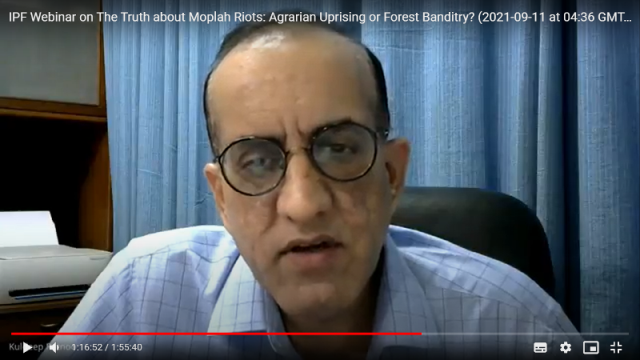
Dr Kuldeep Ratnoo:
Thank you Dr. Harishankar for such detailed and well researched account of the reasons which led to the Moplah riots in 1921. As you mentioned, it wasn’t uprising against the Hindu landlords or the British rulers. There were several factors. You mentioned about 50 riots happening within two decades. And all the riots happened because Muslims wanted to construct mosques adjacent to the Hindu temples and they were denied lands by the Hindus and they got agitated and they indulged in communal riots. Then you also mentioned about the vast timber trade which was monopolised by the rich Moplahs. Then the Britishers and Hindus got into it which agitated the rich Muslim traders of timber. They instigated the masses to indulge in riots against the Hindus. You concluded by saying that so many Hindus were killed and our communists and historians whitewashed it as if it was nothing. They portrayed it as a minor class struggle of Muslim tenants revolting against the exploitation by rich landlords. Now I request participants to add their inputs.
Ganesh Puthur: In Malabar, since the 1850s, there is a history of anti-Hindu attacks by the Muslims. They romanticisedit and called it halellakumin Malayalam. Before Muslims get into halellakum, they take a vow and denounce all their properties. They destroyed Hindu temples, desecrated Hindu idols and many violent incidents were reported. Even now also, most of the people who left to join the Islamic state are from Kerala. And there are multiple incidents of radicalisation that are reported from Kerala daily.
Rajasekharan KV: Any discussion on Malabar riots or the Hindu massacre will be incomplete if we go with a single idea in mind. Today, we have started the correct narrative by stating that it is pan Islamic Khilafat movement. That is the important issue. It was the Malabar variant of the Khilafat. Khilafat movement was never part of India’s independence struggle. It was trying to re-establish the Caliphate and also start a Caliphate in Kerala. That was the goal of Ali Musliyar. He tried to bring the first Caliphate in Kerala. And the most important part of it is that Kashmir and Kerala had similarities. In Kashmir also, the peasants tried to create a feudal unrest like that in Malabar. In Malabar, there was a sizeable number of feudal Moplah landlords especially timber merchants who tried to make use of their religious clout with the help of clergy to attack the Hindus and conquer more land for themselves.
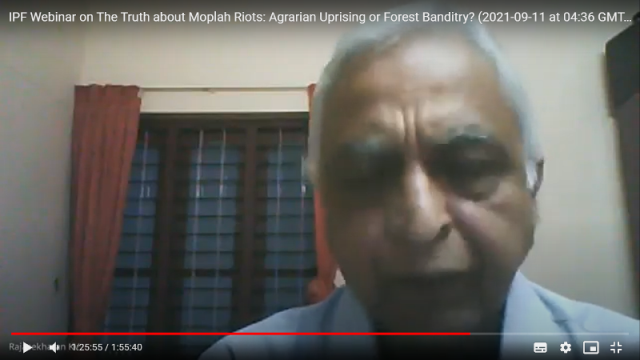
Hiralal Wangnoo: In Kashmir, in one stroke, Sheikh Abdullah dispossessed all Hindus of their lands without any compensation. That was the type of people who would create differences to drive a wedge between Hindus and Muslims.
Ramakrishan Sanjayan: Ali Musliyar was the priest of the Tirurangadi mosque. Formerly he was working in Lakshadweep and had religious training from West Asia. His disciples centred at Tirurangadi were the main people who led these riots. In the earlier riots, the family of Ali Musliyar was also connected.
In conclusion, I can say that theMalabar rebellion which happened 100 years ago is not a closed chapter as far as the experience of Kerala is concerned. Just a few weeks before our Independence, there was a fanatic Muslim who murdered a converted wealthy Mappila who had become a Hindu through Arya Samaj. In 1950s also, there were such riots in Kozhikode district. There was a change in the scenario only after 1960s. After 1980s, in the background of the emergence of global jihadi terror, there was a change in the social scenario of Kerala also. You may have heard about the Marad massacre. Eight fishermen belonging to the Hindu fold were murdered in 2003 at the Marad beach in Kerala. In Kerala, there is a deep tradition of Wahabi Islam. It may assert itself at any moment. The radical Islamic forces have a historic foothold in Malabar. The issue of jihadi terror is still there. That is the most important lesson the people of Kerala should take notice of. Not only that, there are so many modules of Islamic State in Kerala. So many youngsters, especially newly converted youngsters, both boys and girls have gone to West Asia to join Islamic State. So, when we discuss about 1921 Moplah riots, the present situation is more alarming.
Dr Kuldeep Ratnoo:
Thank you Sanjayanji for concluding and highlighting the challenges which we are still facing after the Moplah riots. As you mentioned, more and more youngsters are still identifying with what is happening in Afghanistan or Syria and running away from India to join Islamic State, Taliban and other terror organisations. The Wahabi, jihadi mentality is still firmly rooted in Kerala and it poses a very serious challenge to people not only in Kerala but across the country and even outside it as some youngsters were caught outside India. Some news reports identified Kerala youth behind massacres of Hindus and Sikhs in Afghanistan few months back. All these indications are definitely a cause of worry. We will have to meet again and I would request all of you to read Dr Harishankar’s book, ‘Beyond Rampage.’ This book will definitely provide us more insights about the timber trade and how riots took place mostly in forested region and how agrarian crisis had very little to do with the violence. It is very painful to see complete denial of such mass level massacres and genocide of Hindus by ideologically driven prejudiced historians, who try to whitewash the anti-national actions and beliefs of the jihadis and the Wahabis. I conclude with these remarks.
Thank you!
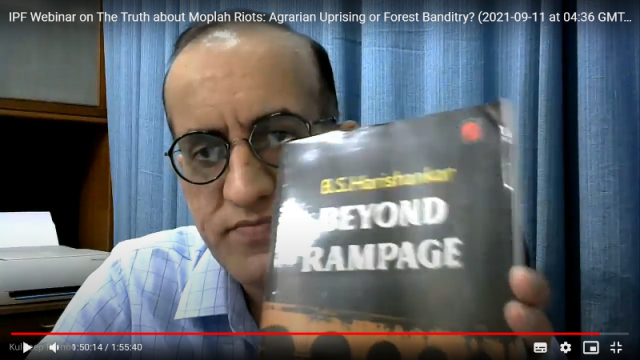
#Moplah #Rampage #Massacre #Hindus #Muslims #Sikhs #Afghanistan #Islamic #Terror #Kerala #Riots #Wahabi #Khilafat #Gandhiji #Congress #Marxist #Malabar #Jihadi